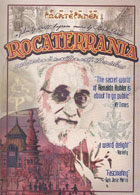
Rocaterrania 2009
Distributed by Bright Eye Pictures, 2410 Springwood Drive, Greensboro, NC 27403; 336-675-5698
Produced by Bright Eye Pictures
Directed by Brett Ingram
DVD, color, 74 min.
Jr. High - Adult
Art, Artists, Drawing, Illustration, Painting
Date Entered: 05/10/2010
Reviewed by Sebastian Derry, Temple UniversityWho is Renaldo Kuhler? It’s a question Rocaterrania attempts to answer, with interesting results.
A resident of Raleigh, North Carolina, Kuhler at first glance seems a mildly eccentric, somewhat curmudgeonly, bearded and pony-tailed seventy-something retiree, with a vivid imagination and a propensity for short pants.
At the beginning of the film he states, “The need for fantasy is greater in the adult than in the child, for fantasy sometimes helps you to escape the unpleasant realties.”
The son of Otto Kuhler, a well-known 20th century American industrial designer, young Ronald Otto Louis Kuhler grew up on a remote ranch in Colorado. Finding this unpleasant reality unbearably dull, Kuhler escapes by creating an imaginary world which would eventually become “Rocaterrania”.
As Kuhler imagined it Rocaterrania is a small country that lies just south of the St. Lawrence River, north of the Adirondacks in New York. In his words it was “founded by people drifting to the north in New York State setting up a new nation there, people that couldn’t understand democracy for what it was, so they set up a “Little Europe” on the rocky terrain, known as “Rocaterrania.”
For the rest of his life Kuhler goes on to design and draw in great detail every aspect of this imaginary country—from its citizenry, fashion, language, religion, customs and technology to its topography, architecture, and history. As an endeavor that has consumed him for nigh on 60 years and filled countless notebooks, sketchpads and scrapbooks, the story and history of Rocaterrania is the story and history of Renaldo Kuhler. And it’s been a secret history until now, something Kuhler never shared with anyone, lest they think there was “something wrong with me” as he puts it.
The film reveals Kuhler to be an artist of uncommon skill, a master of both pen and brush. He’s a draughtsman, an architect, a scientific illustrator, and a calligraphist, rendering even the most mundane images with an astonishing degree of detail. Though he has lived most of his life as a lonely outcast, noted filmmaker Stan Brakhage sought Kuhler out to create the titles for his Dog Star Man film series in the early 1960s.
Essentially this film is Kuhler on Kuhler, notwithstanding several scenes where his sister comments on her reclusive brother. Allowing the subject sole discretion to tell his own story may leave unanswered questions in many viewers’ minds, but director Brett Ingram has probably gotten as close as anyone ever will to this curious, fascinating, yet enigmatic dreamer.
Recommended for all libraries.